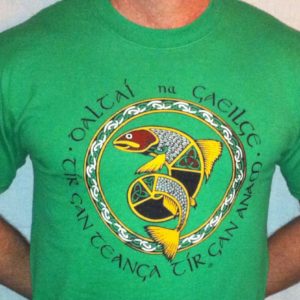Fáilte (Welcome) › Forums › General Discussion (Irish and English) › Slender and Broad – yes, but how do I say it!?
- This topic has 15 replies, 1 voice, and was last updated 11 years, 3 months ago by
Héilics Órbhuí.
-
AuthorPosts
-
January 14, 2013 at 5:31 am #36447
Ní Thuigim
ParticipantHey, I recognize the distinction between broad and slender consonants, and that they need to align beside consonants. What I don’t understand is how do you know which one is pronounced? I look at a word such as “tiontaigh” and I know that the first T is slender and the second is broad, but which actual vowels do I pronounce? Which ones are “original” and which are for orthographical reasons? Is it “Tyintay” or “tyontay,” is O the glide into the broad or is I the glide from the slender? And is there any clear system or way for me to find out/look it up if I find a new word?
January 14, 2013 at 2:02 pm #43038Lughaidh
ParticipantIt depends on the cluster of vowels rather than on the consonants.
In general you can know, but with some clusters you have to learn the pronunciation with every word.
For instance, “io” can be either /o/ or /i/. I’d say it’s more often /o/.
Oi can be either /o/ or /i/ or /e/ too. I’d say it’s more often /i/.
Stressed “ai” is generally /a/ but sometimes /i/ ; unstressed “ai” is always /i/.
Stressed “ui” is almost always /i/.
Stressed “ea” is generally /a/ (but it may change before “mh”, “bh”…, unstressed “ea” is generally /É™/ (but before “ch” it is /a/ in Ulster)etc…
January 15, 2013 at 2:49 am #43042Seáinín
ParticipantIf you can get your hands on a copy of Ó Siadhail’s Learning Irish, there is an extensive section in the back (Appendix I) that looks at most combinations of vowels and neighboring consonants and how they are pronounced in Cois Fhairrge. Much of it is transferrable throughout the island.
I once thought Irish was the most non-phonetic language on the planet. Now I know better. It’s just a matter of learning the somewhat large set of rules.
January 15, 2013 at 2:59 am #43043Lughaidh
ParticipantI once thought Irish was the most non-phonetic language on the planet.
French, English, Tibetan, most dialects of Breton (if you use the “unified spelling”), Manx… are much worse than Irish, and I don’t talk about those languages whose writing isn’t composed of letters or syllables (Chinese, Old Egyptian, etc) 😆
January 15, 2013 at 3:42 am #43044Ní Thuigim
ParticipantI know it’s somewhat phonetic, however only after you hear it pronounced. If you told me it was pronounced “tyontay/chontay” I would understand, but I would also understand if you told me it was “tyintay/chintay.”
January 15, 2013 at 3:43 am #43045Ní Thuigim
ParticipantIf you can get your hands on a copy of Ó Siadhail’s Learning Irish, there is an extensive section in the back (Appendix I) that looks at most combinations of vowels and neighboring consonants and how they are pronounced in Cois Fhairrge. Much of it is transferrable throughout the island.
I once thought Irish was the most non-phonetic language on the planet. Now I know better. It’s just a matter of learning the somewhat large set of rules.
And I will check this out 😉 Thanks!
January 15, 2013 at 4:25 am #43046Seáinín
ParticipantAn example analysis of “tiontaigh” from Ó Siadhail:
io /u/ siopa, iondúil
/i/ when not at beginning of word bior, fios, cion, giota, giodamai /a:/ when in unstressed syllable baile
January 15, 2013 at 4:44 am #43047Lughaidh
ParticipantAn example analysis of “tiontaigh” from Ó Siadhail:
io /u/ siopa, iondúil
/i/ when not at beginning of word bior, fios, cion, giota, giodamai /a:/ when in unstressed syllable baile
Donegal:
/s’apÉ™/, /onduËlˈ/?
/bˈir/, /fˈis/, /kˈon/, /gˈotə/, /gˈodəm/?
/balˈə/(I’m not sure iondúil and giodam exist in Donegal)
Tiontaigh is tiontóigh in Ulster and pronounced /t’ontaj/ (unstressed ó is /a/ in Ulster)
January 15, 2013 at 8:47 am #43048aonghus
ParticipantYou can check pronunciation and get IPA representation of words and phrases using the synthesiser at
There is a Donegal and two Conamara versions (different technologies in the Conamara versions)
January 15, 2013 at 1:07 pm #43050Lughaidh
Participantget IPA representation of words
get a phonological (phonemic) representation of words.
IPA ie. phonetics is much more precise than that…January 15, 2013 at 1:22 pm #43051aonghus
Participantsil tÌªË u . 0 sË É™ É™ nÌ»Ë sË a nʲ . 2 oË . 0 lÌ»Ë iË sil . 0 sil
😉
January 15, 2013 at 1:32 pm #43052Lughaidh
Participantchar thuig mè ‘n jòc! 😀
January 15, 2013 at 1:33 pm #43053aonghus
ParticipantChuir mé “tusa an saineolaí” isteach & d’iarr leagan IPA.
January 15, 2013 at 1:41 pm #43054Lughaidh
Participantok, caithfear “sil” agus “0” agus “2” a bhaint mar sin… cha dtuigim tuighe bhfuil siad san abairt 🙂 fadhb ineacht leis an “copy and paste” gan amhras 🙂
scrìobhfainn [s ˈtɰɪsË É™ nË ËˆsË aɲɔlÉ°i]
January 15, 2013 at 10:22 pm #43057Héilics Órbhuí
ParticipantI recommend picking up a copy of An Gum’s Foclóir Póca. Aside from having a pretty good collection of words for a dictionary that size, it has a rough phonetic transcription of every word on the Irish side. While it won’t tell you EXACTLY how to pronounce the words, it will tell you which vowels are glides and which are pronounced as true vowels.
-
AuthorPosts
- You must be logged in to reply to this topic.
